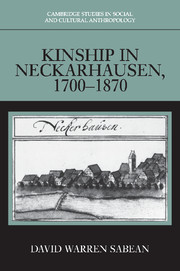Book contents
- Frontmatter
- Contents
- List of tables
- Abbreviations
- Abbreviations of sources
- On reading kinship diagrams
- Glossary
- Preface
- Introduction
- Cohort I (1700–1709)
- Cohort II (1740–1749)
- Cohort III (1780–1789)
- 11 Consanguinity as a principle of alliance
- 12 The formation of an alliance system
- 13 Ritual kinship and alternative alliance
- 14 Naming and patrilineal alliance
- Cohort IV (1820–1829)
- Cohort V (1860–1869)
- Conclusion
- Appendix
- Bibliography
- General index
- Index of villagers
12 - The formation of an alliance system
Published online by Cambridge University Press: 04 August 2010
- Frontmatter
- Contents
- List of tables
- Abbreviations
- Abbreviations of sources
- On reading kinship diagrams
- Glossary
- Preface
- Introduction
- Cohort I (1700–1709)
- Cohort II (1740–1749)
- Cohort III (1780–1789)
- 11 Consanguinity as a principle of alliance
- 12 The formation of an alliance system
- 13 Ritual kinship and alternative alliance
- 14 Naming and patrilineal alliance
- Cohort IV (1820–1829)
- Cohort V (1860–1869)
- Conclusion
- Appendix
- Bibliography
- General index
- Index of villagers
Summary
During the 1740s certain villagers began to marry their consanguineal kin. Within another generation or two, some of their descendants repeated those alliances while other families took up the practice for the first time. By the end of the century, many of Neckarhausen's lines had been allied together for seventy or eighty years and continued to trade marriage partners until they fade from sight at the end of the 1860s. If we confined our view in each case to the particular relationship of a specific couple, we would fail to notice that each marriage was part of a larger strategic situation of patterned exchanges coordinating many households and several generations of people. This chapter examines the shape of just such alliances, which connected families over long periods of time and provided dense networks for political, social, and economic activity. In these alliances, property was inherited equally by all children, including daughters, so that the devolution of real estate gave no structural support for the construction of lineages based on one or the other sex; furthermore, people treated paternal and maternal kin equally for such purposes as reckoning prohibited degrees. Despite these features, lines constructed on agnatic principles – which I have been calling “patrilines” – emerged in the systematic exchange of marriage partners between families over several generations. By the 1780s, however, such a politics of exchange was largely confined to the class of independent landholders and was, in fact, an expression of that class in its self-formation.
- Type
- Chapter
- Information
- Kinship in Neckarhausen, 1700–1870 , pp. 217 - 237Publisher: Cambridge University PressPrint publication year: 1997



